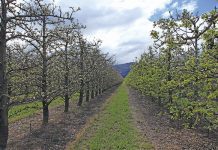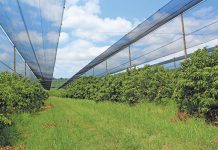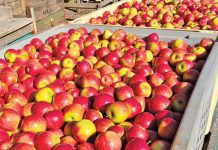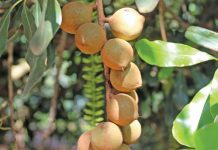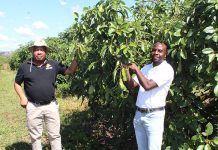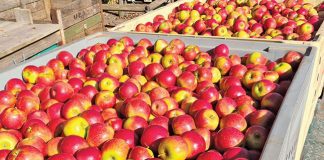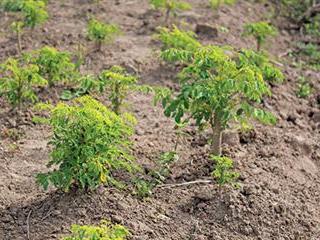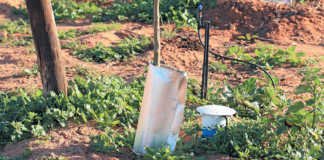
Photo: Glenneis Kriel
Getting a recipe for farming success from Hendrik Botha is not an easy task, as he, modestly, only wants to talk about the way in which the farming community of Stettyn, near Villiersdorp in the Western Cape, is working together to grow their sustainability and create jobs.
“We are a close-knit community, consisting of only a handful of farmers, who are related to one another and grew up together.
“As such, we help each other and look out for one another, and I always have a soundboard I can bounce ideas off. Everything is a team effort,” he says.
Botha recently won the Tru-Cape Award for the highest number of class-one pack-outs and income per hectare for apples.
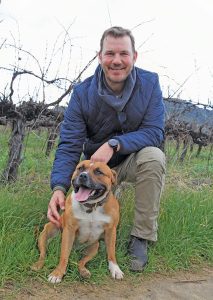
When he finally does talk about pome fruit production, this farmer, who only ventured into pome fruit production in 2012, makes little of the prestigious award: “We only have 21ha under apples and pears, making it much easier to keep a grip on quality than if the farm was bigger,” says Botha.
Venturing into pome fruit production so late also allowed him to learn from other farmers’ experiences.
“The Botha family has been farming at Stettyn since 1818. Over the years the original farm, which has been subdivided multiple times to accommodate follow-up generations, acquired shares in Two-a-Day, which sells fruit via Tru-Cape.
“Two-a-day has been supporting me with a lot of advice ever since I told them I wanted to plant pome fruit,” he says.
He only planted newer varieties, which generally have better pack-outs and market demand than the older ones. These include Early Bon Chretien, Packham’s Triumph, Cheeky and Forelle pears, and Royal Beaut, Flash Gala, Panorama Golden and Golden Delicious apples.
He points out that the Villiersdorp region is warmer than Elgin, Ceres and the Koue Bokkeveld, so he concentrates on varieties that need lower chill units and are less prone to sun damage. Short-radius micros are used for irrigation, with extra pulses added to cool orchards down during heat waves.
Thinking differently
The farm originally only produced wine grapes. Botha diversified into pome fruit and in 2016 into soft citrus to create more sustainable job opportunities on the farm.
They currently have 75ha under vineyards, primarily of Sauvignon blanc, Shiraz, Petit Verdot and Cabernet Sauvignon, and 9,5ha under soft citrus.
He explains that his father, George, was one of the first farmers in the 1980s to buy a wine grape harvesting machine: “Stettyn is big on wine grape production and my father, at the time, realised that it would become increasingly difficult to source enough people to pick all our grapes. We currently harvest around 250t per day.”
An added benefit of mechanical harvesting is that it helps to improve wine quality, by allowing Hendrik to harvest his grapes at optimal ripeness and to get the harvested grapes to the cellar quickly.
“Stettyn Cellar is owned by four shareholders, including me and my father. We share two harvesting machines, which helps to bring mechanisation costs down,” he says.
The vineyards in the region are still pruned and thinned by hand, because the hilly terrain and diverse trellis systems have rendered them unsuited to mechanical pruning.
The planting of the orchards has allowed him to employ 10 more people permanently, taking his permanent workforce to 45, and roughly 20 people more during the fruit picking season.
He says a key priority is to simplify work as far as possible to prevent mistakes and ensure the smooth running of operations: “To prevent inefficiencies, you need to ensure workers know exactly what to do, which entails regular training and making it as easy as possible for them to do a good job.”
Botha holds weekly staff meetings to talk through work and challenges experienced and finds ways to further improve operations.
The farm’s organisational chart helps clarify where each person fits into the business to avoid duplication and confusion and inspire workers to further growth: “The more the skills, the higher up the ladder and income a person can go.”
Picking
A lot of effort is put into ensuring a good picking job. For instance, instead of tractors driving in orchards with workers as they pick, Botha has created tractor roads that go between the orchards, where the workers have to deliver fruit. The orchard rows, in effect, have been shortened to 25m.
The switch has helped to reduce compaction within the orchards, save fuel and reduce damages to the fruit trees. It has also improved worker efficiency, as walking distances have been shortened, and workers no longer have to squeeze past tractors, which also results in fewer damaged fruit. Along with this, it is easier to monitor workers.
“Where it would have taken me over an hour to check up on teams, the tractor roads allow me to do so in a matter of minutes,” he says.
The bottoms of the trees are picked clean, before ladders are used to pick the tops of the trees. This further reduces the amount of fruit that falls from the tree and bruises during picking.
In addition, picking teams are kept small, with one strong team leader, 12 pickers and four sorters per team. The teams are incentivised to work carefully.
Botha explains that each team leader texts him a photo of the bins they have picked every hour, so he can monitor their picking pace: “The industry norm is for a picking team to pick about 3,3 bins per hour, but my target is three bins, as picking slower reduces bruising that might occur when pickers and sorters work too rough with fruit.”
Instead of using electronic tags to monitor the number of bags picked, he makes use of clip systems, where a worker’s job chart is clipped for each bag delivered. He explains that this allows workers to physically see how many bags they have picked and to keep a track of their picking pace.
It also makes it easier for the team leader to identify and sort out the workers who are picking too fast or too slow.
The picking data is entered into a spreadsheet at the end of the day and combined with inspection results, based on the inspection of five apples per bin.
The bonus percentage each team receives is based on the inspection results and whether the teams have packed their quotas. Workers can make an additional R50 per day if none of the inspected fruit is bruised, he says.
Regulating picking this way has the added advantage of allowing Botha to better plan transport logistics, which in turn helps to reduce costs. He concedes that it takes a lot of work, and he would not have been able to manage the picking season in such fine detail if the area under pome fruit was larger.
Other activities
To save costs and improve farmworker efficiency, Botha mechanises wherever he can. They use double row sprayers, which his father built, in the vineyards to reduce compaction and save fuel costs.
He recently acquired electric pruning shears, which are used to cut down the thick shoots, while hand shears are used on thinner shoots. The shears are powered using rechargeable batteries.
Botha plans to also start using the electric shears in his orchards too. Attie van Zyl, managing director of Two-a-Day, praises Botha and his wife, Wena, for being progressive and innovative farmers.
“They are an excellent example of the modern South African farmer. They have a heart for their staff and are working behind the scenes for their workers and their children,” says Van Zyl.
Email Hendrik Botha at [email protected].


